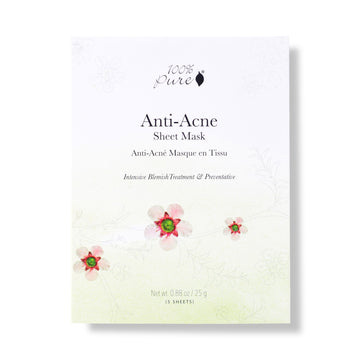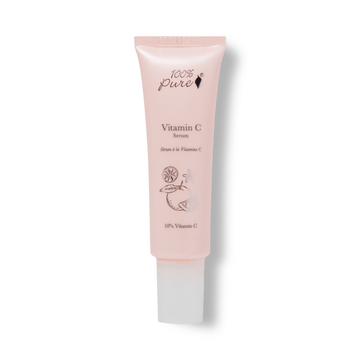Wondering What These Are and Which One to Choose? We’ll Be Your Guide – Plus Delve Into the In’s and Out’s of Exfoliation for Brighter, More Youthful Skin.
Posted on December 20, 2024 Written by: 100% PURE®
To BHA, or not to BHA: Is that really the question? Not when there are also powerful AHAs to contemplate for your skin.
Alpha hydroxy acids and beta hydroxy acids are skin care ingredients that can be found in a variety of products for concerns from anti-aging to acne. Though their names may sound confusing like excerpts from “Hamlet”, both tend to be relatively gentle exfoliants that won’t have you fleeing for CliffsNotes.
We’re here to demystify these two powerful groups of skin care acids, their primary benefits and differences for different skin types, and how to use these beneficial ingredients for your skin. No ‘questions’ asked!

What Are Alpha Hydroxy Acids Vs. Beta Hydroxy Acids?
We don’t know about you, but all the past seasonal skin damage has got us seeing spots – and not the kind that you see after accidentally looking at the sun or other bright light for too long. It’s no secret that summer and fall are the seasons for outdoor fun – and let’s not forget winter’s UV-damaging snow reflection - until our skin starts to show wear and tear.
Instead of our skin getting us down like the winter blues, it’s time to make room between the snow angels, sledding – or snowless outdoor adventures - for exfoliation. Enter alpha hydroxy acids (AHAs) and beta hydroxy acids (BHAs). Both these effective exfoliators can help to boost your glow! But are they an all-glow for all glowers out there? Let’s find out!
Alpha hydroxy acids are a type of water-soluble chemical exfoliant that are great for targeting the surface of your skin. These acids are chemical compounds that are found naturally in common foods, and especially in fruits. Green apple, berries, and citrus fruits (although lactic acid is derived from dairy products) are all natural sources of alpha hydroxy acids.
Unlike AHAs, beta hydroxy acids (BHAs) are oil-soluble – an important feature, as it allows these types of acids to penetrate the skin barrier. The best-known (and most commonly used) beta hydroxy acid is salicylic acid. This BHA is usually derived from the bark of willow trees, and is found in clarifying products from cleansers to toners to face masks.
How Do Alpha Hydroxy Acids and Beta Hydroxy Acids Work?
The effects of alpha hydroxy acids tend to be limited to the surface of your skin. When you apply a mask, a cream, or another product that contains AHAs, it’ll help to eliminate dead cells from your skin’s surface. This will soften your skin, even out your complexion, and possibly also encourage collagen production.
Alpha hydroxy acids are often found in anti-aging products due to their potential to enhance the skin’s outer appearance and texture, from smaller pores to improved skin clarity. The most commonly used alpha hydroxy acids in skin care are glycolic (derived from sugar cane), lactic (derived from dairy products and fermented produce), and citric (derived from citrus) acids.
The fact that beta hydroxy acids are oil soluble makes them especially effective when applied to oily, acne-prone skin. These acids can penetrate your skin’s surface through your follicles, sinking more deeply into your skin tissue than AHAs. Not only do BHAs help to exfoliate your skin and clear up your pores, they also have antibacterial and anti-inflammatory properties to help fight breakouts, which is why salicylic acid is popular in acne treatments.

How to Choose AHAs or BHAs For Your Skin Type
The first step in choosing which acid for your skin exfoliation to use depends on your skin type. Understand that some exfoliators are stronger than others, which can sometimes lead to irritation or dryness, especially if you have finicky skin.
If you have normal to combo skin, your skin will favor products with AHAs. They are gentle enough if your skin teeter totters on dry to normal and potent enough to balance combo skin without stripping it. If you have combo skin and you’re battling sun damage, our Vitamin C Mask will banish dark spots and discoloration and includes a powerful blend of fruit enzymes to sweep up the leftovers.
If you have oily and acne-prone skin, your skin may enjoy a salicylic acid (BHA) product. Salicylic acid is oil-soluble, so it can penetrate oily pores easily and help control oil production. You can find it in our Anti Acne Masks: easy-to-use sheet masks that help to clear up problem skin while keeping it hydrated and supplied with nutrients.
If you have dry or sensitive skin, you’re not being left out to dry. You may find that glycolic or salicylic acid is too much for your skin to handle. If this is the case, have no fear; you have daily to count on – as in lactic acid. It doesn’t penetrate the skin as deeply – less irritation for the win!

Tips for Using Alpha Hydroxy Acids and Beta Hydroxy Acids
To prevent damage to your skin and optimize your exfoliation process, here are important tips and guidelines for how to use AHAs and BHAs:
How to begin using AHAs and BHAs
If you’ve never learned how to exfoliate with an acid before, you don’t want to jump straight into using higher percentages – start low and slow. Where you can start depends on how sensitive your skin is and your skin type.
When to exfoliate
Using an AHA or BHA in the morning, then going out into the sun is a big no! Alpha and beta hydroxy acids can make skin more sensitive to the sun, so use your exfoliators at night. Even when you wake up and get ready to go out, use sunscreen and reapply every 2 hours.
How to exfoliate without irritation
Avoid applying AHAs and BHAs on wet skin; wait until your skin is fully dry to use it. As hydroxy acids (especially glycolic and salicylic acid) can dry out your skin, you always want to replenish your moisture levels afterwards. Don’t use any other irritating ingredients like alcohol or astringents that can dry out your skin.
How to exfoliate the right amount
Listen to your skin: some may be able to use a AHA or BHA daily, but others can only handle exfoliating 2-3x a week. Signs of over-exfoliation include: Dryness, irritation, flaking, burning, and breakouts.
Skin Care to Pair with Your Alpha Hydroxy Acids and Beta Hydroxy Acids
For all skin types (even sensitive skin), we have a must-have in the quest for boosting collagen production, reducing fine lines and wrinkles, and combating free radicals. We’ve packed our serum with ingredients that work synergistically with stabilized vitamin C to improve skin’s texture and appearance, and powerful antioxidants for post-exfoliation nourishment. Plus, pairing AHAs or BHAs with this serum can enhance brightness and promote even skin tone.
This serum is perfect to follow up with AHAs for anyone targeting dull or uneven skin. Formulated to combat hyperpigmentation, dullness, and uneven skin tone, it contains ingredients like vitamin C, and niacinamide to inhibit melanin production, exfoliate dead skin cells, and reveal a more luminous complexion. The addition of sake, fruit acids, and licorice gently brightens skin tone and supports cellular turnover for a luminous complexion.
This physical exfoliator is a great alternative for days when you’re not using AHAs or BHAs. This nutrient-rich scrub offers a delightful blend of gentle physical exfoliation and nourishing ingredients. Formulated with acai pulp and natural exfoliants, this scrub helps to buff away dead skin cells, revealing a smoother texture. It features antioxidant-rich berries to refresh and smooth the skin, and its hydrating properties ensure that your skin feels soft and moisturized post-exfoliation, making it suitable for regular use without the fear of irritation.
AHAs and BHAs are powerful, natural skin care ingredients that can improve texture and minimize pores to promote cellular turnover and restore luminosity. The best part is that these all-star acids are diverse – there’s something for every skin type! Take advantage of the enhanced product penetration and follow up with a night mask, which has plenty of big benefits for skin!
Frequently Asked Questions About AHAs and BHAs
What is the difference between alpha hydroxy acids (AHAs) and beta hydroxy acids (BHAs)?
AHAs are water-soluble and work on the skin's surface, while BHAs are oil-soluble and can penetrate deeper into pores. AHAs are generally better for normal skin types, while BHAs are generally better for oily and sensitive skin types. AHAs are ideal for minimizing fine lines and reducing sun damage, while BHAs are good for reducing the appearance of fine lines and wrinkles, and improving skin texture.
How do AHAs benefit your skin?
AHAs help to remove the top layer of dead skin cells, revealing fresh new cells underneath. AHAs can even out skin tone and treat hyperpigmentation. AHAs can reduce the appearance of wrinkles and fine lines and can improve overall skin texture. With long-term use, AHAs may also increase collagen and elastin in the skin.
What are the benefits of using BHAs for oily or acne-prone skin?
BHAs, particularly salicylic acid, are beneficial for oily or acne-prone skin because they are oil-soluble, allowing them to penetrate deep into pores to remove excess oil, dead skin cells, and debris, effectively reducing blackheads, whiteheads, and overall acne breakouts while also having anti-inflammatory properties to calm redness associated with blemishes; making them ideal for congested pores and oily skin types.
Which exfoliant should I choose if I have sensitive or dry skin?
If you have sensitive or dry skin, you should choose a chemical exfoliant with gentle acids like lactic acid as it’s less irritating than physical scrubs and can effectively exfoliate without causing further dryness or redness; look for products with hydrating ingredients like hyaluronic acid or aloe vera. If you experience irritation, reduce the frequency or consult a dermatologist for personalized advice.
How often should I use AHAs or BHAs in my skincare routine?
When starting out with AHAs or BHAs in your skincare routine, it's best to use them once or twice a week and gradually increase frequency as your skin adjusts, depending on its tolerance and the product strength; for most people, using them every other day is a good starting point, but always listen to your skin and adjust accordingly. Always apply sunscreen when using AHAs or BHAs as they can increase sun sensitivity.
- Tags: December-2024, Ingredients, Skin Care
We carefully hand-select products based on strict purity standards, and only recommend products we feel meet this criteria. 100% PURE™ may earn a small commission for products purchased through affiliate links.
The information in this article is for educational use, and not intended to substitute professional medical advice, diagnosis, or treatment and should not be used as such.


















